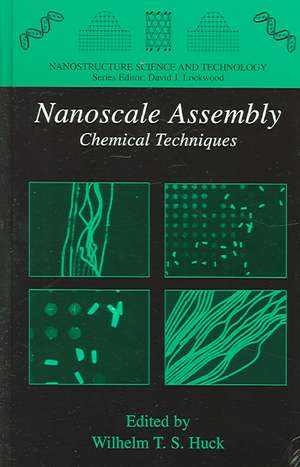Nanoscale Assembly: Chemical Techniques: Nanostructure Science and Technology
Editat de Wilhelm T.S. Hucken Limba Engleză Hardback – 13 iul 2005
| Toate formatele și edițiile | Preț | Express |
|---|---|---|
| Paperback (1) | 638.43 lei 6-8 săpt. | |
| Springer Us – 27 noi 2014 | 638.43 lei 6-8 săpt. | |
| Hardback (1) | 642.68 lei 6-8 săpt. | |
| Springer Us – 13 iul 2005 | 642.68 lei 6-8 săpt. |
Din seria Nanostructure Science and Technology
- 18%
 Preț: 1114.65 lei
Preț: 1114.65 lei - 18%
 Preț: 1001.02 lei
Preț: 1001.02 lei - 24%
 Preț: 834.57 lei
Preț: 834.57 lei -
 Preț: 405.66 lei
Preț: 405.66 lei -
 Preț: 405.28 lei
Preț: 405.28 lei - 18%
 Preț: 947.35 lei
Preț: 947.35 lei - 18%
 Preț: 734.27 lei
Preț: 734.27 lei - 15%
 Preț: 696.02 lei
Preț: 696.02 lei - 20%
 Preț: 585.29 lei
Preț: 585.29 lei - 20%
 Preț: 556.90 lei
Preț: 556.90 lei - 15%
 Preț: 646.62 lei
Preț: 646.62 lei - 18%
 Preț: 947.50 lei
Preț: 947.50 lei -
 Preț: 397.97 lei
Preț: 397.97 lei -
 Preț: 406.05 lei
Preț: 406.05 lei - 18%
 Preț: 967.08 lei
Preț: 967.08 lei - 18%
 Preț: 947.50 lei
Preț: 947.50 lei - 18%
 Preț: 948.29 lei
Preț: 948.29 lei - 18%
 Preț: 950.03 lei
Preț: 950.03 lei - 18%
 Preț: 951.29 lei
Preț: 951.29 lei - 18%
 Preț: 948.92 lei
Preț: 948.92 lei - 18%
 Preț: 960.13 lei
Preț: 960.13 lei - 19%
 Preț: 559.01 lei
Preț: 559.01 lei - 15%
 Preț: 694.69 lei
Preț: 694.69 lei - 15%
 Preț: 635.15 lei
Preț: 635.15 lei - 15%
 Preț: 640.06 lei
Preț: 640.06 lei - 18%
 Preț: 948.79 lei
Preț: 948.79 lei - 20%
 Preț: 564.27 lei
Preț: 564.27 lei - 20%
 Preț: 628.33 lei
Preț: 628.33 lei - 15%
 Preț: 647.59 lei
Preț: 647.59 lei - 15%
 Preț: 643.16 lei
Preț: 643.16 lei - 15%
 Preț: 643.34 lei
Preț: 643.34 lei - 18%
 Preț: 955.08 lei
Preț: 955.08 lei - 15%
 Preț: 587.72 lei
Preț: 587.72 lei - 15%
 Preț: 649.87 lei
Preț: 649.87 lei - 15%
 Preț: 646.43 lei
Preț: 646.43 lei -
 Preț: 388.72 lei
Preț: 388.72 lei - 18%
 Preț: 955.25 lei
Preț: 955.25 lei - 5%
 Preț: 716.75 lei
Preț: 716.75 lei - 18%
 Preț: 952.89 lei
Preț: 952.89 lei - 18%
 Preț: 1258.46 lei
Preț: 1258.46 lei
Preț: 642.68 lei
Preț vechi: 756.09 lei
-15% Nou
Puncte Express: 964
Preț estimativ în valută:
122.97€ • 128.40$ • 101.78£
122.97€ • 128.40$ • 101.78£
Carte tipărită la comandă
Livrare economică 05-19 aprilie
Preluare comenzi: 021 569.72.76
Specificații
ISBN-13: 9780387236087
ISBN-10: 0387236082
Pagini: 244
Ilustrații: VII, 244 p.
Dimensiuni: 155 x 235 x 17 mm
Greutate: 0.48 kg
Ediția:2005
Editura: Springer Us
Colecția Springer
Seria Nanostructure Science and Technology
Locul publicării:New York, NY, United States
ISBN-10: 0387236082
Pagini: 244
Ilustrații: VII, 244 p.
Dimensiuni: 155 x 235 x 17 mm
Greutate: 0.48 kg
Ediția:2005
Editura: Springer Us
Colecția Springer
Seria Nanostructure Science and Technology
Locul publicării:New York, NY, United States
Public țintă
ResearchCuprins
Structure Formation in Polymer Films From Micrometer to the sub-100 nm Length Scales.- Functional Nanostructured Polymers Incorporation of Nanometer Level Control in Device Design.- Electronic Transport through Self-Assembled Monolayers.- Nanostructured Hydrogen-Bonded Rosette Assemblies Self-Assembly and Self-Organization.- Self-Assembled Molecular Electronics.- Multivalent Ligand-Receptor Interactions on Planar Supported Membranes An On-Chip Approach.- Aggregation of Amphiphiles as a Tool to Create Novel Functional Nano-Objects.- Self-Assembly of Colloidal Building Blocks into Complex and Controllable Structures.- Self-Assembly and Nanostructured Materials.
Recenzii
From the reviews:
"The timely topic of Nanoscale Assembly encompasses such a large and expanding body of work that W. T. S. Huck was both wise and insightful to focus the scope of his book onto Chemical Techniques. Moreover, by gathering authors with contrasting backgrounds in chemistry and physical chemistry, the editor showed a genuine will to stimulate a debate … . the individual contributions are good introductions to their respective fields. … this book could be useful for students or for general multidisciplinary reading … ." (Erik Dujardin, Angewandte Chemie, Vol. 45 (28), 2006)
"The timely topic of Nanoscale Assembly encompasses such a large and expanding body of work that W. T. S. Huck was both wise and insightful to focus the scope of his book onto Chemical Techniques. Moreover, by gathering authors with contrasting backgrounds in chemistry and physical chemistry, the editor showed a genuine will to stimulate a debate … . the individual contributions are good introductions to their respective fields. … this book could be useful for students or for general multidisciplinary reading … ." (Erik Dujardin, Angewandte Chemie, Vol. 45 (28), 2006)
Textul de pe ultima copertă
Recent advances have pushed the limits of lithography firmly into the sub-100 nm domain, with smallest feature sizes around 10 nm. However, compared to living organisms, devices fabricated using nanolithography are not nearly as complex, as they are essentially 2D and contain only a limited number of chemical elements. For centuries, Nature has been a major inspiration for science. First of all to learn how Life functions at cellular level, but increasingly, as a blueprint for designing non-natural devices where the building blocks and their assembly are inspired by biological examples. The key tool in translating these examples into the domain of engineering, has been self-assembly or self-organization. This book gathers a spectrum researchers who have not only furthered our knowledge of self-assembly using small molecules, polymers and colloidal particles as building blocks, but who have also shown it to be a practical tool in the assembly of an astonishing variety of devices, ranging from molecular electronics to biosensors.
Caracteristici
Takes a closer look at a great variety of different strategies that are being pursued to assemble and organize nanostructures into larger assemblies and even into functional devices or materials










